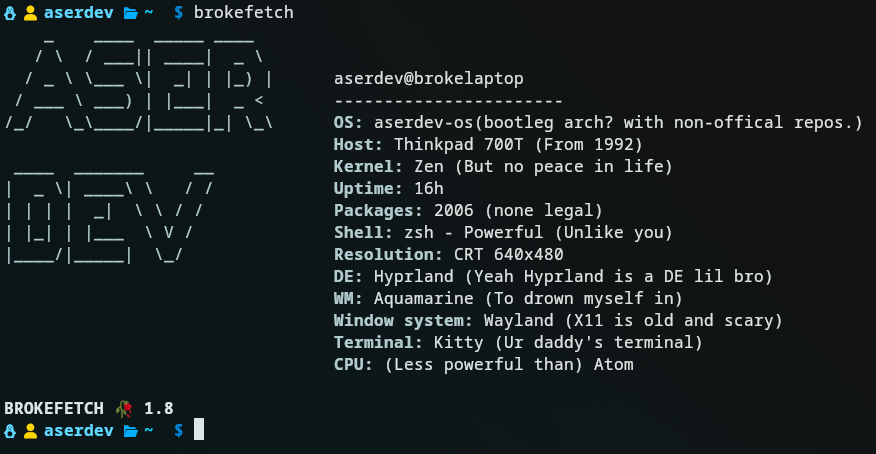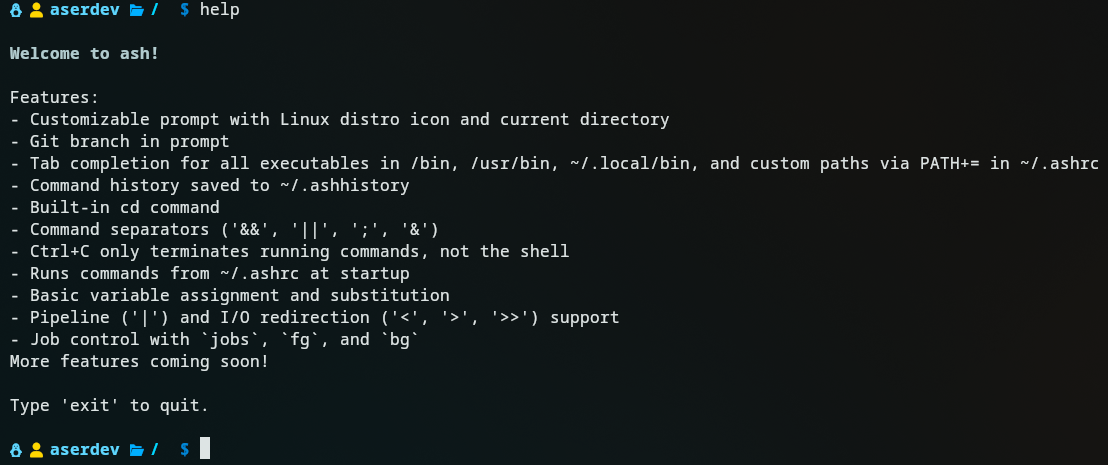ash-shell
Lightweight and customizeable shell for Linux made in "C"
Source codeDocumentation
ash-shell is a linux shell designed for gnu/linux
⚠️warning:
this shell is full of buggs and in an early stage i don't recomend using it daily untill i make sure that it is safe enough to use, but feel free to use in a VM or in a test enviroment
features
POSIX-Compliant Core: The fundamental process management, I/O redirection, and signal handling are built on POSIX standards for reliability and portability.
Advanced Command Execution: Supports pipelines |, logical AND &&, logical OR || and running apps in the background &(buggy)
I/O Redirection: Handles input< and output >(buggy) and redirecting to a text file >>
Built-in Commands: Includes essential commands like cd, exit, history, help, jobs,fg, and bg(sometimes buggy)
Job Control:(bugged): manage em with jobs make em foreground fg and move em to background with bg
Configuration: Supports a customizable user experience through a startup script ~/.ashrc and a config file ~/.config/ash.conf
prompt: Displays the current working directory and a customizable icon based on your Linux distribution.
prompt
help command
Alias Support: Define custom aliases in ~/.ashrc to simplify complex or frequently used commands.
alias <alias_name>='<command>'
Command History: Utilizes readline for a familiar interactive history and line editing experience, with history saved to ~/.ashhistory
Variable Support: Assign and expand shell variables.
how to script (so bugged)
You can write standard shell scripts and execute them with ash. The scripting syntax is highly compatible with other POSIX-compliant shells(kinda). warning⚠️: run the script inside the shell not outside of it like do ./script insted ash script cuss it will freak out
#!/bin/ash
# A simple example script for the ash shell.
# 1. Variable Assignment
# Sets the name of the log file we'll be working with.
LOG_FILE="script_output.log"
echo "Using log file: $LOG_FILE"
# 2. Command Execution and Output Redirection (>)
# Creates a new file and writes the first line to it.
echo "Starting script at $(date)" > "$LOG_FILE"
# 3. Appending to a file (>>)
# Adds a second line without overwriting the first one.
echo "---" >> "$LOG_FILE"
echo "This is a second line of text." >> "$LOG_FILE"
# 4. Pipelines (|)
# Lists files and pipes the output to grep to check for the log file.
echo
echo "Verifying file creation with a pipeline:"
ls -l | grep "$LOG_FILE"
# 5. Logical AND (&&)
# This command runs only if the previous grep command was successful.
grep "$LOG_FILE" "$LOG_FILE" && echo "File check successful!"
# 6. Basic command execution
# Displays the final contents of the log file.
echo
echo "Final contents of the log file:"
cat "$LOG_FILE"
# 7. Clean up
# Removes the created file.
rm "$LOG_FILE"
echo
echo "Script finished. File '$LOG_FILE' has been removed."
using ~/.ashrc
The ~/.ashrc file is executed every time the shell starts up. This is the ideal place to define aliases and set up your environment.
# Set aliases for common commands
alias ll='ls -alF'
alias h='history'
alias gcl='git clone'
# Add custom paths to the PATH environment variable
export PATH+=:/path/to/my/bin
Modifying ~/.config/ash.conf
# ash-shell configuration file
#
# first_time: Whether this is the first time running the shell.
# - This is automatically set to true after the first run.
#
# hide_icon: Set to true to hide the Linux distro icon from the prompt.
# - To hide the icon, change this to `hide_icon=true`.
first_time=true
hide_icon=false
contribute
fell free to contribute to this project in github
Install Options
Option 1 — pacman
install aserdev-repo and install with pacman
Option 2 — cmake
install cmake and compile in "C"
Screenshots / Logos


















